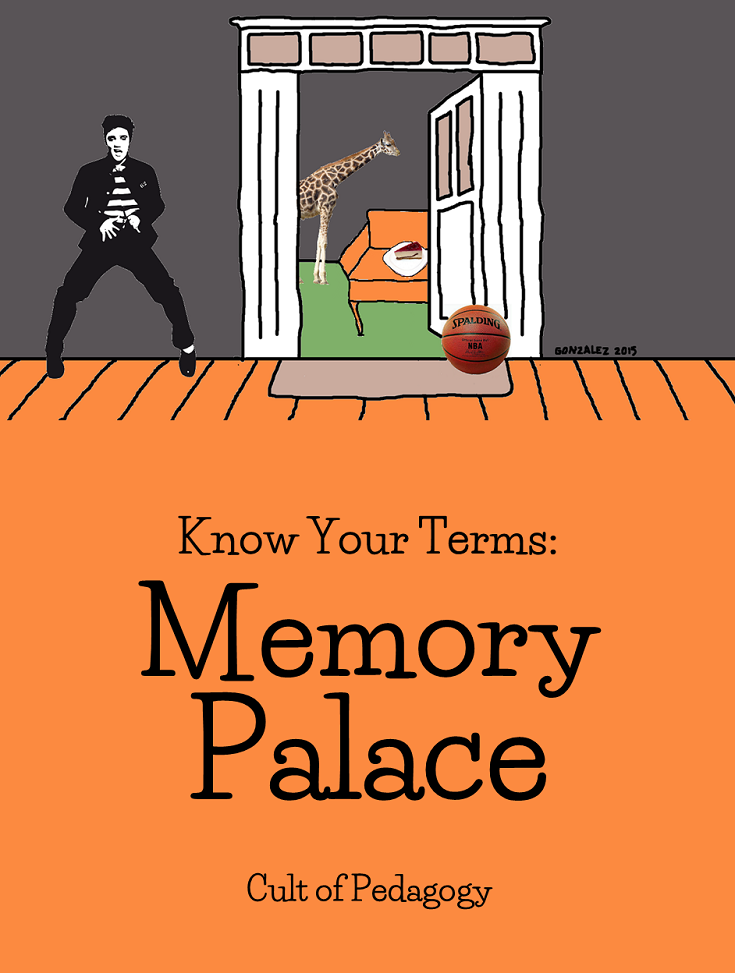Know Your Terms: Memory Palace

memory palace
(noun) A mnemonic device that helps people remember items by visualizing those items in specific, familiar locations, often in a specific, familiar sequence. Also known as the method of loci.
You may call upon the mnemonic Every Good Boy Does Fine and FACE to remember the notes of a treble clef. You might use Roy G. Biv to recall the colors of a rainbow. These and other mnemonic devices help us remember things we have trouble keeping in long-term memory. One mnemonic you may not have heard of is called a memory palace. I learned this term over the summer while reading Make It Stick: The Science of Successful Learning, and was utterly delighted by it. A memory palace! It makes learning sound fancy, like it comes with its own butler and scullery maid.
Here’s how a memory palace works: You start with some collection of facts, a list of items, or a sequence of things you want to remember. Next, you choose a location you’re very familiar with: your bedroom, your childhood home, a restaurant you go to frequently. Mentally walking through that place, in the order you’d typically travel through it, you begin placing the objects on your list in specific spots. It’s important to tie these in with familiar items in your location, make the placement as specific as possible, and make the connection a little strange, if you can. Once all the items have been placed, imagine yourself walking through your “palace,” encountering each item as you progress. By visualizing this path with each item in a sequence, you strengthen your ability to recall each item and the order in which it comes.
Suppose I have to give a speech. I want to do it without using index cards. Like a TED Talk, I want to be able to just get up and deliver this beautiful, well-rehearsed talk with finesse. My presentation will start with an Elvis joke, followed by a story about a lesson I learned while watching my son play basketball. Next, I will talk about my main topic—happiness turning up when you least expect it. Finally, I will finish by talking about how we need to use our natural-born gifts to find more of these joys. (By the way, this is a totally fictional speech. I have not written it or given it anywhere. It doesn’t sound half bad, though.)
To construct my memory palace for this speech, I might picture the front porch of my house, and imagine Elvis standing there to greet me. That’s the joke at the beginning. Next, there’s a basketball waiting on the doormat, a cue to remember to tell the basketball story. As I enter the house, I see a piece of cheesecake sitting on an armchair—happiness turning up when I least expect it. Finally, I picture a giraffe hanging out in the back of the room. Giraffes have long necks that enable them to access high-growing food that can’t be reached by other animals; that’s using your natural-born gifts to find joy, the end of my presentation. Now, all I have to do to remember the key elements of my talk is picture myself walking through the house, encountering each of these things.
How Teachers Can Use Memory Palaces
Include memory palaces in your instruction.
When you want students to remember a specific sequence or list of items, use your own classroom, another part of your school, or even a familiar location in your town as a memory palace. Go to this place—either mentally or physically—and work with students to associate items on your list with specific locations in your chosen palace. Doing this as a group will further reinforce the associations, because students will be able to help each other remember.
Teach students how to construct their own memory palaces.
As a general study technique, the memory palace is a great one to have in your repertoire. So teach students how to create their own and let them know when you’re studying something that would be a good fit for a memory palace. Learning how to do in-depth analytical writing isn’t the kind of material that lends itself to a memory palace, but remembering the steps of the scientific method would be perfect.
Use memory palaces to deliver more polished presentations.
When you have the opportunity to present at a professional conference, have to give a workshop to your colleagues, or if you just want to deliver a memorable lecture to your students, use memory palaces to secure more of your content in long-term memory.
Watch a Memory Palace in Action
Other Resources
Learn to Remember Everything: The Memory Palace Technique, by Ruben Berenguel at Mostly Maths
Develop Perfect Memory with the Memory Palace Technique, by Luciano Passuello at Litemind
Ancient Imagery Mnemonics, by Nigel J.T. Thomas in the Stanford Encyclopedia of Philosophy
I would love to have you come back for more. Join my mailing list and get weekly tips, tools, and inspiration—in quick, bite-sized packages—all geared toward making your teaching more effective and joyful. To thank you, you’ll get a free copy of my e-booklet, 20 Ways to Cut Your Grading Time in Half. I look forward to getting to know you better!